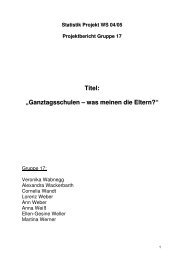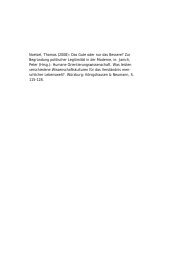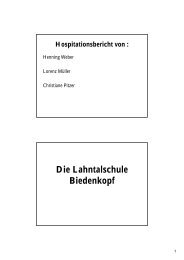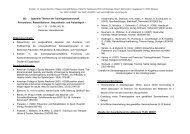of K - Philipps-Universität Marburg
of K - Philipps-Universität Marburg
of K - Philipps-Universität Marburg
Create successful ePaper yourself
Turn your PDF publications into a flip-book with our unique Google optimized e-Paper software.
2<br />
Ā. They have all been edited by E. V. V. RĀGHAVĀCHĀRYA, SHARMA in the collection Laghukāvyasagraha<br />
(Minor Works <strong>of</strong> Kemendra, 1961).<br />
K¤emendra’s “Minor Works” are poems or didactic works including poems <strong>of</strong> minor length, their<br />
function being mainly to serve nīti, i.e: moral or political wisdom, or conduct <strong>of</strong> the statesman.<br />
More generally, however, all aphoristic and ethical poetry, that is to say, verses concerned only with<br />
a single erotic or religious sentiment could be considered as laghukāvyas.<br />
K¤emendra mentions four kinds <strong>of</strong> composition in his work on metrics, Suvttatilaka III.2:<br />
science (śāstra), poetry (kāvya), poetry in science (śāstrakāvya), and science in poetry (kāvyaśāstra).<br />
His didactic and satirical works seem to fall into the third category “poetry in science”<br />
(Suvttatilaka III.4), pertaining to the “four-fold pursuit <strong>of</strong> man” (caturvarga) and providing “instructions<br />
to all” (sarvopadeśa). K¤emendra holds that works on science and poems which are <strong>of</strong><br />
Purāa-type or didactic exposition should be written in the metre Anu¤ubh (śloka).<br />
Eleven works by K¤emendra have been published since the end <strong>of</strong> the<br />
“Bibliography<strong>of</strong>K¢emendra’sMinorWorks”<br />
19 th century after he was<br />
“rediscovered” by Indian and Western scholars (cf. R. MITRA 1871, G. BÜHLER 1873). The starting<br />
point were the editions <strong>of</strong> the satirical poem Kalāvilāsa and the critical discourse on propriety in<br />
Aucityavicāracarcā<br />
(Kāvyamālā poetical composition, collection, part 1, Niraya Sāgara Press,<br />
Bombay, 1886, by DURGĀPRASĀD and PARAB).<br />
SŪRYAKĀNTA suggests in Kemendra Studies (1954, p.1), that “most <strong>of</strong> his works, numbering<br />
about thirty-two, have been published while some are yet in their manuscript form.” This judgement<br />
seems somewhat overly-optimistic and I cannot agree with SŪRYAKĀNTA in this respect. To my<br />
knowledge, no further manuscripts <strong>of</strong> K¤emendra, besides the 16 extant works and two miscellanea,<br />
Lokaprakāśa and Nītikalpataru, have either been found or published.<br />
While critical works on K¤emendra’s immense Buddhist kāvya, Bodhisattvāvadānakalpalatā2<br />
and its Tibetan translation have been published, critical editions <strong>of</strong> the “Laghukāvyas”, besides<br />
LAPANICH’s edition <strong>of</strong> the Kalāvilāsa (1973) and MOHRDIEK’s critical edition <strong>of</strong> chapter 1-2 <strong>of</strong> the<br />
Darpadalana (2002), are still desiderata. Only some parts <strong>of</strong> the Daśāvatāracarita have been translated<br />
into Italian by O. BOTTO (1951) as “Il poeta Kshemendra e il suo Daśāvatāracarita”.3<br />
Inner Chronology <strong>of</strong> K¡emendra’s Poems<br />
The problems <strong>of</strong> the inner chronology <strong>of</strong> K¤emendra’s works have been discussed by ŚĀSTRĪ<br />
KAUL<br />
(1923) in his edition <strong>of</strong> Deśopadeśa and Narmamālā. Further suggestions regarding his biography<br />
and chronology are found in SŪRYAKĀNTA (1954), MAHAJAN (1954), DATTARAY (1974) and, more<br />
recently, FORMIGATTI (2005). The following list <strong>of</strong> the extant works was suggested by<br />
SŪRYAKĀNTA (1954, pp. 16ff), with some modifications:<br />
2 Cf. KIRDE, (in German) “Bibliographie zur Bodhisattvāvadānakalpalatā”, in Śikhisamuccaya, Indian and Tibetan<br />
Studies. Ed. by D. DIMITROV, U. ROESLER and R. STEINER. Wien (2002) (Wiener Studien zur Tibetologie und Buddhismuskunde<br />
53), pp. 109-128, (in Japanese) IWAI S., “K§emendra no denki-teki kijutsu ni tsuite”, in Indogaku Bukkyogaku<br />
Kenkyu (Journal <strong>of</strong> Indian and Buddhist Studies), Vol. L, 1, Dec. 2001, pp. 56-59, (in Italian) FORMIGATTI<br />
(2005), pp. 28-38, 49-51, (in German) M. STRAUBE, Prinz Sudhana und die Kinnarī: eine buddhistische Liebesgeschichte<br />
von Kemendra: Text, Übersetzung, Studie. <strong>Marburg</strong> 2006 (Indica et Tibetica Verlag 46).<br />
3 O. BOTTO, “Il Poeta K§emendra e il suo Daśāvatāracarita”, reprinted in: Scritti Scelti di Oscar Botto. A cura di M.<br />
D’Onza CHIODO, E. PANATTONI and S. PIANO. Torino (1993), pp. 44-86.











